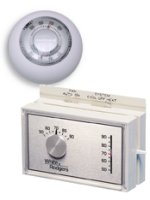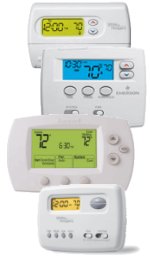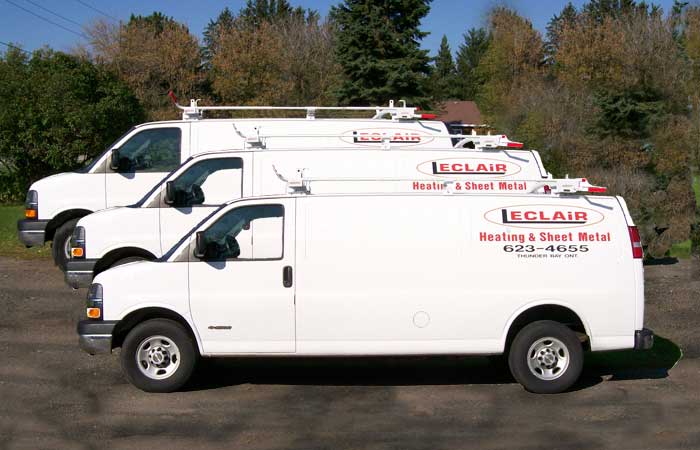



Authorized TRANE Dealer

Leclair Heating & Sheet Metal.
All rights reserved.
2613 McGregor Pl. Thunder Bay, Ontario P7E 5G9
Phone: (807) 623-4655
Mechanical Thermostats

The conventional thermostat has been around for over 100 years.
The older models have a mercury switch attached to a bi-metal spring. When the room cools down, the bi-metal spring tips the mercury switch, turning on the furnace.
As the temperature in the room rises, the spring starts to tip the switch back, until, when the set-point is reached, the furnace shuts off.
Conventional thermostats available today are mercury free, having a snap-action switch attached to the spring to control the temperature.
Heat Anticipator
Thermostats have a neat device called a heat anticipator. The heat anticipator shuts off the heater before the air inside the thermostat actually reaches the set temperature. The metal parts of the heating system, the furnace itself and the heat pipes, retain heat after the burner shuts off. The anticipator shuts the heater off a little early to give the heat time to reach the thermostat.
A conventional thermostat simply regulates house heating at one temperature. For instance, in the winter, if you set the thermostat to 20°C (68°F), it will activate the heating system when the house temperature drops below 20°C and will shut the system off when the house air warms up past 20°C.
Save with Your Manual Thermostat
You can still make the most of your manual thermostat by adjusting the temperatures daily before you leave the house and when you go to sleep at night. Typically, adjusting temperatures 3 - 8 C (5 - 8 F) degrees down in winter can help save energy if you're going to be away from home for several hours.
Setback Thermostats
What is a Setback Thermostat?
Thermostats control heating and cooling appliances in houses. A setback thermostat gives the user the option of changing the temperature setting automatically at night and also during the work day when the occupants have left the house. A setback thermostat can help reduce overall household energy consumption.
A setback thermostat contains an electronic clock. It can automatically turn down the temperature setting at night, when you are asleep, or during the day, when you are at work. It can also return the temperature to a more comfortable level before you wake up or arrive home from work. That way, you can have the energy savings of a lowered thermostat setting without the discomfort of having to wait for the house to heat up again.

The setback thermostat can also be used as a set-forward thermostat for an air-conditioning system. It can allow the house to heat up when it is unoccupied and return it to a comfortable temperature before occupants return from daytime activities.
You can use a standard thermostat to set your house temperature lower during times when the house is unoccupied. This will lead to similar energy savings as with a setback thermostat but without the convenience.
A setback schedule works best for people with predictable work and sleep periods. If your schedule is completely irregular, you might as well simply turn down a conventional thermostat when you sleep or leave the house, rather than trying to anticipate it with a setback thermostat.
Does Setting Back the Temperature Save Energy?
Yes. Research from the Canadian Centre for Housing Technology shows that winter setbacks for the houses tested would result in heating cost savings of five to fifteen per cent. The highest savings came with a setback of 6 C° (11 F°).
Savings for the summer were about the same, although simply raising the thermostat set point in the summer from 22°C (71°F) to 24°C (75°F) led to more significant savings than the set-forward strategy and also offered better indoor humidity control.
One common myth is that when you reduce the thermostat for only a few hours it will take more heat to bring your home back up to the desired temperature. This is not so. You will save money and fuel because your heating system will not have to keep your home so warm. You will use less energy overall even when you warm up your house from a cooler temperature.
Programmable Thermostats
The easiest way to save heating dollars is to lower the temperature setting on your house thermostat. As a general rule, you will save 2 percent on your heating bill for every 1 C° you turn down the thermostat overnight or when you're going to be away from home for several hours.
A programmable thermostat will adjust your home's temperature automatically. These thermostats have a timer that allows you to preset household temperatures for specific periods of the day and night.
You could program the thermostat to reduce the temperature a short while before you go to bed and to raise it again before you get up in the morning. You could also program it to reduce the temperature for any period during the day when the house is unoccupied and to restore the temperature shortly before you return.
A good guide is to have the temperature set at 17°C (63°F) when you are sleeping and 14°C (57°F) when not at home and at 20°C (68°F) when you are awake and home. Experiment with the unit until you find the most comfortable and economical routine for you and your family. ENERGY STAR qualified programmable thermostats offer at least four daily temperature settings (such as wake, day, evening, sleep) for at least two different program periods (for example, weekdays and weekends). A hold feature allows you to temporarily override the program for a period such as a vacation.

When used properly, ENERGY STAR labelled thermostats can save you 10 to 15 percent on your heating bills.
More sophisticated electronic and self-tuning thermostats are also being developed. These sensitive devices help reduce temperature swings from an average range of between 1.5°C and 2°C to a range of between 0.5°C and 1°C. As a result, the heating system turns on and off as close to the required temperatures as possible. Energy savings from these mechanisms can vary, but they usually enhance comfort.
Which programmable thermostat is right for me?
A setback schedule works best for people with predictable work and sleep periods.
The simplest model has a 24 hour program, that repeats itself every day of the week. This will allow you to automatically setback the temperature overnight, and wake up to a warm house, without the worry of forgetting to turn it down or up.
Other models have a weekday - weekend program, sometimes referred to as a "5+2" program. Another has a "5+1+1" program, allowing Weekdays, Saturdays and Sundays to have different temperatures. For people with varying schedules, a 7 day thermostat allows each day of the week to have a separate program.
Limitations on programmable thermostats
If the members of your household (small children and their caregivers, older retirees) are generally home during the day - you are limited to the "sleep" program period for setting back the thermostat. A programmable thermostat will not be as effective in saving energy in this case.
If you have radiant floor heat, or steam radiator heat - it may be more difficult to use a programmable thermostats due to slow response time and the "thermal mass" generated by these systems. The adaptive recovery features of newer thermostats can assist with this issue by initiating heating earlier in order to arrive at the correct temperature at the correct programmed time. We find that with some trial and error - even a radiant heat system can be programmed via a thermostat to save some energy - though not as much as a conventional forced air system. Of course - radiant heat is generally more energy efficient to begin with.

